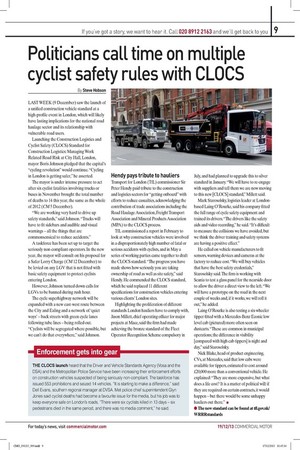Politicians call time on multiple cyclist safety rules with CLOCS
Page 7

If you've noticed an error in this article please click here to report it so we can fix it.
By Steve Hobson
LAST WEEK (9 December) saw the launch of a unified construction vehicle standard at a high-profile event in London, which will likely have lasting implications for the national road haulage sector and its relationship with vulnerable road users.
Launching the Construction Logistics and Cyclist Safety (CLOCS) Standard for Construction Logistics: Managing Work Related Road Risk at City Hall, London, mayor Boris Johnson pledged that the capital's "cycling revolution" would continue. "Cycling in London is getting safer," he asserted.
The mayor is under intense pressure to act after six cyclist fatalities involving trucks or buses in November brought the total number of deaths to 14 this year, the same as the whole of 2012 (CMS December).
"We are working very hard to drive up safety standards," said Johnson. "Trucks will have to fit sidebars and audible and visual warnings — all the things that are commonsensical to reduce accidents."
A taskforce has been set up to target the seriously non-compliant operators. In the new year, the mayor will consult on his proposal for a Safer Lorry Charge (CM12 December) to be levied on any LGV that is not fitted with basic safety equipment to protect cyclists entering London.
However, Johnson turned down calls for LGVs to be banned during rush hour.
The cycle superhighway network will be expanded with a new east-west route between the City and Ealing and a network of 'quiet ways' — back streets with green cycle lanes following tube lines — being rolled out. "Cyclists will be segregated where possible, but we can't do that everywhere," said Johnson. Hendy pays tribute to hauliers
Transport for London (TfL) commissioner Sir Peter Hendy paid tribute to the construction and logistics sectors for "getting onboard" with efforts to reduce casualties, acknowledging the contribution of trade associations including the Road Haulage Association, Freight Transport Association and Mineral Products Association (MPA) to the CLOCS process.
TfL commissioned a report in February to look at why construction vehicles were involved in a disproportionately high number of fatal or serious accidents with cyclists, and in May a series of working parties came together to draft the CLOCS standard. "The progress you have made shows how seriously you are taking ownership of road as well as site safety," said Hendy. He commended the CLOCS standard, which he said replaced 11 different specifications for construction vehicles entering various clients' London sites. Highlighting the proliferation of different standards London hauliers have to comply with, Jason Millen, chief operating officer for major projects at Mace, said the firm had made achieving the bronze standard of the Fleet Operator Recognition Scheme compulsory in
July, and had planned to upgrade this to silver standard in January. "We will have to re-engage with suppliers and tell them we are now moving to this new [CLOCS] standard," Millen said.
Mark Starosolsky, logistics leader at Londonbased Laing O'Rourke, said his company fitted the full range of cycle safety equipment and trained its drivers. "The drivers like the safety aids and video recording," he said. "It's difficult to measure the collisions we have avoided, but we think the driver training and safety systems are having a positive effect."
He called on vehicle manufacturers to fit sensors, warning devices and cameras at the factory to reduce cost. "We will buy vehicles that have the best safety credentials," Starosolsky said. The firm is working with Scania to test a glass panel for the nearside door to allow the driver a direct view to the left. "We will have a prototype on the road in the next couple of weeks and, if it works, we will roll it out," he added.
Laing O'Rourke is also testing a six-wheeler tipper fitted with a Mercedes-Benz Econic low level cab (pictured) more often seen on dustcarts. "These are common in municipal operations; the difference in visibility [compared with high cab tippers] is night and day," said Starosolsky. Nick Blake, head of product engineering, CVs, at Mercedes, said that low cabs were available for tippers, estimated to cost around £20,000 more than a conventional vehicle. He explained: "They are more expensive, but what does a life cost? It is a matter of political will: if they are required on certain contracts, it would happen — but there would be some unhappy hauliers out there." • • The new standard can be found at tfl.gov.uk/ WRRRstandards










































